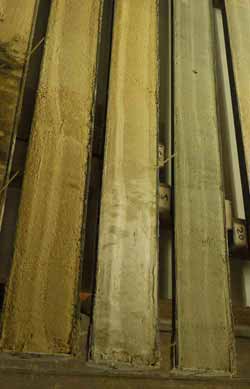How Antarctica turned white

Typical deep ocean sediment cores. Scientists use geochemical signals hidden in these sediments to reconstruct Earth’s climate history.<br>Katharina Pahnke<br>
Thirty four million years ago, Antarctica was covered with temperate forests that included beech trees and cycads. Then, over a geologically short period of 200,000 years, global temperatures cooled and Antarctica became the frozen continent it is today. These pervasive climatic changes may be linked to weathering processes on the Antarctic continent.
Dr. Chandranath Basak of the Max Planck Research Group Marine Isotope Geochemistry located at the University of Oldenburg, and his co-author Dr. Ellen Martin from the University of Florida found out that weathering of different types of rocks contributed towards the observed climate change at the Eocene/Oligocene boundary.
For this study they used deep-sea sediments obtained from the Integrated Ocean Drilling Program, a large-scale programme for scientific ocean drilling. In their publication in the scientific journal Nature Geoscience they suggest that weathering processes on the Antarctic continent may have been instrumental in lowering the carbon dioxide concentrations in the atmosphere, causing the observed climate cooling and subsequent ice growth.
When rocks are subjected to weathering, they can change the chemistry of the ocean, and the remnants sooner or later end up at the bottom of the ocean. Scientists can “read” such events in Earth’s history from these sediments, deposited over millions of years. They use characteristics in the composition of the sediment by which they can reconstruct processes in the past. Dr. Basak and Dr. Martin have analysed lead (Pb) isotopes in sediment samples and used a new approach to study weathering of the continents in the past.
“This method allows us to differentiate between chemical weathering, meaning alteration by chemical processes, and physical weathering, for example breakdown by glaciers”, says Dr. Basak. They could find evidence of carbonate rock weathering on Antarctica during ice growth, which may have contributed to chemical changes in the ocean that led to enhanced carbonate deposition, which is referred to as an ocean de-acidification event in contrast to modern ocean acidification.
Chandranath Basak says: “It is not easy to reconstruct the processes associated with climate change that occurred millions of years ago during the Eocene-Oligocene transition. Yet with our work we believe we could improve our understanding of this transitional period.”
For further information please contact:
Dr. Chandranath Basak, cbasak@mpi-bremen.de Telephone: 0441 798 3359
Or the press office:
Dr. Rita Dunker rdunker@mpi-bremen.de Telephone 0421 2028 856
Dr. Manfred Schlösser mschloes@mpi-bremen.de Telephone 0421 2028 704
Involved Institutions:
Max Planck Institute for Marine Microbiology
Max Planck Research Group for Marine Isotope Geochemistry, Instutite for Chemistry and Biology of the Marine Environment, University of Oldenburg, Oldenburg, Germany
University of Florida, Department of Geological Sciences, Gainsville, USA
Original Publication:
Basak, C. and Martin, E.E. (2013). Antarctic weathering and carbonate compensation at the Eocene-Oligocene transition. Nature Geosciences, advanced online Publication.
Doi: 10.1038/NGEO1707
Media Contact
More Information:
http://www.mpi-bremen.deAll latest news from the category: Earth Sciences
Earth Sciences (also referred to as Geosciences), which deals with basic issues surrounding our planet, plays a vital role in the area of energy and raw materials supply.
Earth Sciences comprises subjects such as geology, geography, geological informatics, paleontology, mineralogy, petrography, crystallography, geophysics, geodesy, glaciology, cartography, photogrammetry, meteorology and seismology, early-warning systems, earthquake research and polar research.
Newest articles

Superradiant atoms could push the boundaries of how precisely time can be measured
Superradiant atoms can help us measure time more precisely than ever. In a new study, researchers from the University of Copenhagen present a new method for measuring the time interval,…

Ion thermoelectric conversion devices for near room temperature
The electrode sheet of the thermoelectric device consists of ionic hydrogel, which is sandwiched between the electrodes to form, and the Prussian blue on the electrode undergoes a redox reaction…

Zap Energy achieves 37-million-degree temperatures in a compact device
New publication reports record electron temperatures for a small-scale, sheared-flow-stabilized Z-pinch fusion device. In the nine decades since humans first produced fusion reactions, only a few fusion technologies have demonstrated…





















